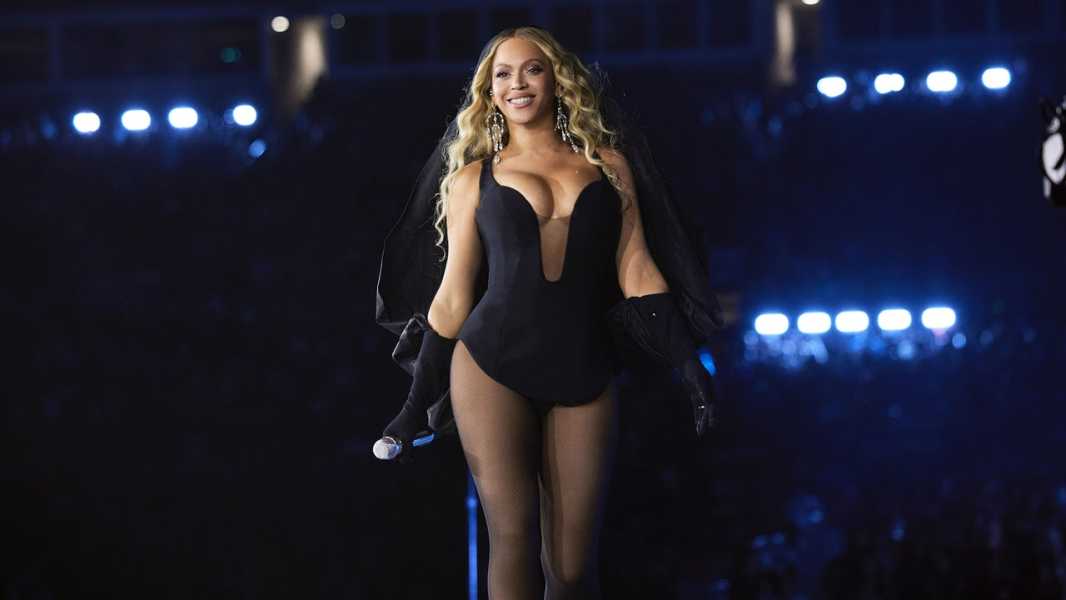
Save this storySave this storySave this storySave this story
For the past decade, Beyoncé has been using documentary film to craft a narrative about herself in the absence of traditional press interviews and public appearances. Her films, which include “Life Is But a Dream” (2013) and “Homecoming” (2019), attempt to show audiences just how much labor is involved in the extraordinary job of being Beyoncé. In “Homecoming,” the Netflix documentary she released to supplement her historically ambitious 2018 Coachella performance, the brunt of the work on show was physical. “Homecoming” takes place months after Beyoncé gave birth to twins, and emphasizes just how brutal the diet, training, and choreography regimen that she undertook leading up to such an ambitious production was. In a voice-over that accompanies footage of her struggling through a piece of choreography, she says, “I had to rebuild my body from cut muscles. . . . In order for me to meet my goal, I’m limiting myself to no bread, no carbs, no sugar, no dairy, no meat, no fish, no alcohol. And I’m hungry.” Then she explains that she has learned a valuable lesson: “I will never, never push myself that far again.”
“Renaissance,” the superstar performer’s new concert film, which draws on footage of a global tour Beyoncé commenced in May this year and completed in October, shows the artist making good on that promise. The tour issues from her 2022 album of the same name, a dance record born out of a need to escape the ennui and claustrophobia of the pandemic’s prime time. As a paean to underground house and disco scenes and queer communities of the eighties and nineties, the album might have been Beyoncé’s most physical. But in the film, viewers see comparatively little of the elaborate, athletic choreography that has defined Beyoncé’s presence in so many of her other projects. Onstage, she uses dancers and set design to create movement, while she often sits, calm and regal, at the center of the storm. It’s a choice that allows her true gifts to shine through. Given the size of Beyoncé’s cultural footprint, it can be easy to forget that the forty-two-year-old is, at her core, a once-in-a-generation vocalist, but the film foregrounds this fact in delightful ways. It opens not with a rousing medley or cinematic intro but with a block of ballads that finds her trilling toward the limits of her vocal range.
The “Renaissance” tour is a maximalist project, among the most extravagant that Beyoncé has ever undertaken. The retrofuturism of the record, which borrows signatures of nineties house music and drag-ball culture, flows neatly into the stage show’s visual elements. The performance is punctuated with moments that blend whimsy, theatricality, and camp. During “Alien Superstar,” Beyoncé is enveloped in metallic pillows and a comforter, at which point she closes her eyes and tilts her head to the side, as if she’s taking a nap. Other parts of the show find her nestled inside an enormous iridescent clamshell, or sporting an elaborate bee costume while stationed behind a news anchor’s desk. Beyoncé may not be living out the hedonistic late-night dance-club dreams of “Renaissance” ’s lyrics in real life, but in this playfulness it seems as if she may have found a form of ecstatic freedom.
Like “Homecoming,” “Renaissance” mixes invigorating concert footage shot on various tour dates with artful clips from behind the scenes. In these portions, Beyoncé is more forthcoming than she has been in public for years. But her disclosures seem largely intended to direct the limelight to the show’s creation—the technology, the costuming, the dancers, the swarms of backstage production workers, and also her fans, her collaborators, and her oldest daughter. (That’s not to say that we can’t expect her fingerprints on every facet of the show: at one point, she elaborates on her abiding and autodidactic interest in lighting design.) The film, which runs nearly three hours long, emphasizes the staggering efforts that went into the tour’s making. Describing the vast amount of materials and manpower needed to create the set every night, Beyoncé notes, “It took four years to create this show. . . . This tour is a machine,” before pointing up to a screen so large that its content is visible across a football stadium. “You don’t realize that screen was built by hand.”
This summer, Beyoncé’s “Renaissance” performances overlapped with Taylor Swift’s Eras Tour, generating a live-pop-music doubleheader of epic proportions—a Barbenheimer for the music industry—as well as unprecedented expense. Tickets for the Eras Tour originally retailed for between forty-nine and four hundred and ninety-nine dollars, but they were so highly coveted, and so difficult to snag, that resale prices climbed into the thousands. Retail ticket prices for floor seats at “Renaissance” shows were north of a thousand dollars. Both artists have brought concert films to movie theatres as a consolation for the legions of fans who couldn’t, logistically or financially, swing the live shows—and to capitalize on their megastardom, a quality that is vanishingly rare in a world of fractured fans distinguished by highly specific tastes. This proved to be, for both women, a characteristically shrewd choice: In less than two months, the “Eras” film has already generated a quarter of a billion dollars in ticket revenue globally, and during its opening weekend “Renaissance” was No. 1 at the box office.
But the two artists have chosen radically different paths. Swift took the least fussy route available, using footage from shows at a single venue (SoFi Stadium, in Los Angeles). Though some of its set pieces are elaborate, “Eras” is a straightforward representation of a performance, and its proposition is simple: here is one woman and her never-ending collection of hit songs. Most of the action takes place through Swift’s facial expressions, or the light flicks of her wrist that count as her choreography.
“Renaissance,” aside from depicting a more grandiose affair, also has much loftier aspirations. One of these is to weave together an artist’s personal history with broader narratives of creative and technological evolution, an objective the film accomplishes in part by bridging the story of Beyoncé’s late uncle Johnny, who was gay, and the queer dance influences she draws from. Another is to provide a platform for undersung performers plucked from across the past few decades of American music. In doing so, the film continues Beyoncé’s recent spate of thoughtful and effective attempts to spotlight influential or innovative artists whose talents may have not received their appropriate due. Some of the most absorbing footage in “Renaissance” features Kevin JZ Prodigy, a longtime legend of the Philadelphia ballroom scene, who was recruited to m.c. the tour. Reams of footage showing the crowds in communal rapture, dressed in left-field ensembles, prove that Beyonce’s aim to “create a safe space” for her fans on the tour is not just a hollow, buzzword-based promise, but a hard-won reality.
Still, for Beyoncé the filmmaker and autobiographer, one narrative-building feat seems to remain out of reach. For her past several albums, she has been engaged in a war against her own perfectionism—striving for some kind of release from it, and for the world to see her humanity. In a behind-the-scenes video that was released during the rollout of her self-titled album, in 2013, she lamented the hollow satisfaction of all the prizes she’d worked for since childhood, which, in the video for the song “Pretty Hurts,” are symbolized by a trophy wall. “The trophy represents all of the sacrifices I made as a kid, all of the time that I lost,” she says. “And I just want to blow that shit up.”
A decade later, she is still on this mission. Early in the film, she announces that she is “embracing every flaw.” To that end, the film relates some of the technological hiccups that occurred at a handful of shows. These are flaws, sure, but not defining ones. And when the film begins to grapple in earnest with imperfection, it gets a little clammy. It is not until near the end that Beyoncé finally discusses the physical fact that surely helped to shape the tone and structure of the performance: shortly before rehearsals began, she relates, she underwent surgery for an old knee injury that had been aggravated. “I don’t feel the need to move around so much to give my best performance,” she explains. “My voice is my instrument.” Here is a glimpse of a deeply human limitation—even of mortality—but the film quickly moves on, returning to the nearly unbounded effort expended in the pursuit of another superhuman performance. ♦
Sourse: newyorker.com






